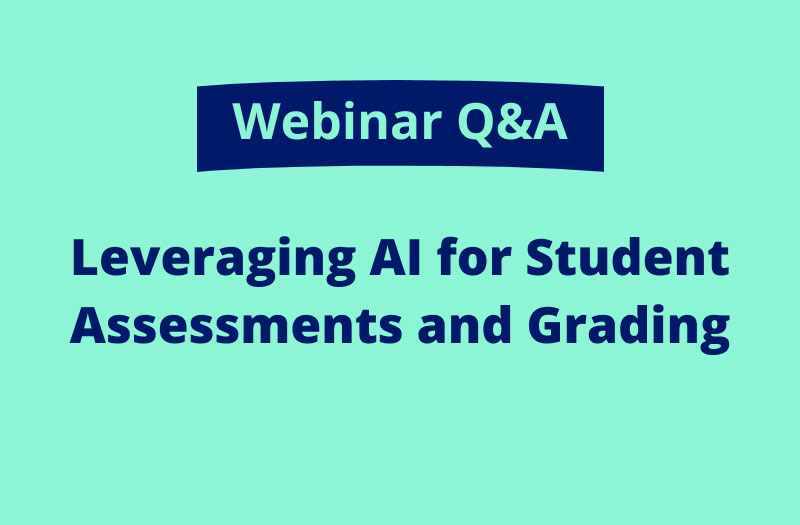
Leveraging AI for Student Assessments and Grading: Webinar Q&A
Meet our AI Grading Panel



-
Drs. Janet Parish and Sandi Lampo, Clinical Professor of Marketing Mays Business School, Texas A&M University,
-
Stian Fyrand, Senior Marketing and Operations Manager at Hubro Simulations
Is AI Elevating Learning in Business Education?
Can AI elevate student learning — or are we just dressing up automation in academic robes? That was the big question tackled in our recent webinar, Leveraging AI for Student Assessments and Grading. Faculty leaders and tech experts joined forces to unpack how AI is changing the game in business education, especially through simulation-based learning.
The panel included Drs. Janet Parish and Sandi Lampo, clinical professors of marketing at Texas A&M University’s Mays Business School, and Stian Fyrand, Hubro Simulations’ senior marketing and operations manager. Together, they shared real-world takes on AI-powered grading, pedagogical shifts and the classroom’s evolving role in the age of algorithms.
With hundreds of educators tuning in live from across the globe, the session delivered big insights — and even bigger questions. Here’s a curated roundup of the standout moments from the Q&A segment.
Teaching with AI and Simulations: From the classroom to the curriculum
1. Are students actually learning, or are they just outsourcing to AI?
Dr. Lampo: “They can’t. The simulation creates unique outcomes based on every group’s decisions. Generic answers generated by AI don’t align with the data, and our grading model picks up on that. We’ve seen that students actually try harder, because they know they can’t fake it.”
2. How do you teach AI literacy?
Dr. Parish: “We don't have a university-wide AI policy yet, but as marketing educators, it's our responsibility to teach students how to use AI tools. We show them when and how to apply AI effectively — but we also talk about where it's limited.”
3. Have you updated your learning outcomes to reflect AI's role?
Dr. Parish: “We haven’t rewritten course learning outcomes specifically for AI, but we’ve absolutely integrated it into our delivery. We talk about AI in the context of tech stacks, marketing tools and content creation workflows.”
4. What about grading bias and ethical concerns?
Dr. Lampo: “We make a clear distinction between generative AI, which can hallucinate or pull outdated data, and what we’re using in the simulation, which is trained on rubrics and structured feedback. That’s a different model entirely.”
5. What makes a good AI policy?
Dr. Parish: “We need flexible, contextual policies. AI is everywhere now — banning it outright would be like banning calculators. But we still need ways to assess what students are learning, not just what they can generate.”
6. Is AI coming for our jobs as educators?
Stian Fyrand: “No. It’s not about replacing the teacher — it’s about augmenting what we can do. When grading is automated, teaching faculty get time back to coach students and focus on higher-level discussions.”
Want to see the full webinar?
Hubro AI grading and Simulation Design
1. How does Hubro’s AI grading actually work?
Stian Fyrand: “Our system is trained on actual rubrics and educator-provided feedback. It looks at students’ answers in the context of the simulation data to assess relevance, accuracy and completeness.”
2. Which courses are best suited for Hubro AI Grading?
Stian Fyrand: “Our grading feature is available in most of our business-focused simulations, including marketing and sustainable business. Right now, it’s best suited for scenario-based courses where decision-making and reflection are key.”
3. What’s the difference between the AI Grading for the student and the instructor?
Stian Fyrand: “Students get a streamlined experience — submit answers, receive feedback — while instructors get the full dashboard. They can override grades, view analytics and track learning outcomes over time.”
4. Can I still use a textbook?
Dr. Lampo: “Absolutely. We’ve used textbooks, but we’ve also run classes with no textbook at all. The simulation provides enough depth and data for applied assignments like persona development, market segmentation and strategy.”
Final Takeaways on AI Grading
This webinar drove home a powerful truth: AI is not a threat to education. It is a catalyst for transformation. When used in tools like Hubro’s Sustainable Marketing Simulation, AI becomes a springboard for deeper learning. It pushes students to think critically, apply knowledge in context, and stay engaged. Shortcuts simply will not work. The takeaway is clear: when students know they cannot game the system, they rise to meet the challenge.
Ethical conversations are not optional. They are embedded in the lesson plan. And with new certificate and minor programs focused on AI already in development at Texas A&M and elsewhere, it is clear that forward-thinking institutions are reimagining what modern education can be.
“The AI doesn’t do the thinking for students—it challenges them to think better.”
Dr. Janet Parish
Watch the Full Webinar On-Demand
Click here to access the recording. Explore the full discussion, see how the grading works, and hear more from the experts.
Book a free trial meeting to see how it works
Get a free trialExplore more of our blog for business education, educational business simulations and remote teaching methods.
Back to the blog